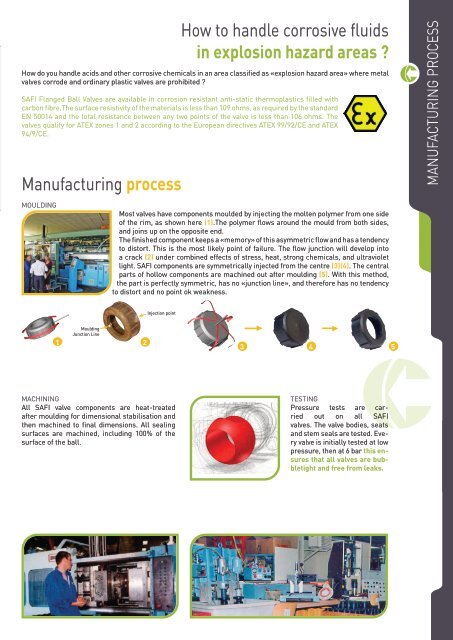Flanged ball valve - Safi
Flanged ball valve - Safi
Flanged ball valve - Safi
Create successful ePaper yourself
Turn your PDF publications into a flip-book with our unique Google optimized e-Paper software.
How to handle corrosive fluids<br />
in explosion hazard areas ?<br />
How do you handle acids and other corrosive chemicals in an area classified as «explosion hazard area» where metal<br />
<strong>valve</strong>s corrode and ordinary plastic <strong>valve</strong>s are prohibited ?<br />
SAFI <strong>Flanged</strong> Ball Valves are available in corrosion resistant anti-static thermoplastics filled with<br />
carbon fibre.The surface resistivity of the materials is less than 109 ohms, as required by the standard<br />
EN 50014 and the total resistance between any two points of the <strong>valve</strong> is less than 106 ohms. The<br />
<strong>valve</strong>s qualify for ATEX zones 1 and 2 according to the European directives ATEX 99/92/CE and ATEX<br />
94/9/CE.<br />
Manufacturing process<br />
MOULDING<br />
1<br />
Moulding<br />
Junction Line<br />
MACHINING<br />
All SAFI <strong>valve</strong> components are heat-treated<br />
after moulding for dimensional stabilisation and<br />
then machined to final dimensions. All sealing<br />
surfaces are machined, including 100% of the<br />
surface of the <strong>ball</strong>.<br />
Most <strong>valve</strong>s have components moulded by injecting the molten polymer from one side<br />
of the rim, as shown here (1).The polymer flows around the mould from both sides,<br />
and joins up on the opposite end.<br />
The finished component keeps a «memory» of this asymmetric flow and has a tendency<br />
to distort. This is the most likely point of failure. The flow junction will develop into<br />
a crack (2) under combined effects of stress, heat, strong chemicals, and ultraviolet<br />
light. SAFI components are symmetrically injected from the centre (3)(4). The central<br />
parts of hollow components are machined out after moulding (5). With this method,<br />
the part is perfectly symmetric, has no «junction line», and therefore has no tendency<br />
to distort and no point ok weakness.<br />
2<br />
Injection point<br />
3<br />
4 5<br />
TESTING<br />
Pressure tests are carried<br />
out on all SAFI<br />
<strong>valve</strong>s. The <strong>valve</strong> bodies, seats<br />
and stem seals are tested. Every<br />
<strong>valve</strong> is initially tested at low<br />
pressure, then at 6 bar this ensures<br />
that all <strong>valve</strong>s are bubbletight<br />
and free from leaks.<br />
MANUFACTURING PROCESS


